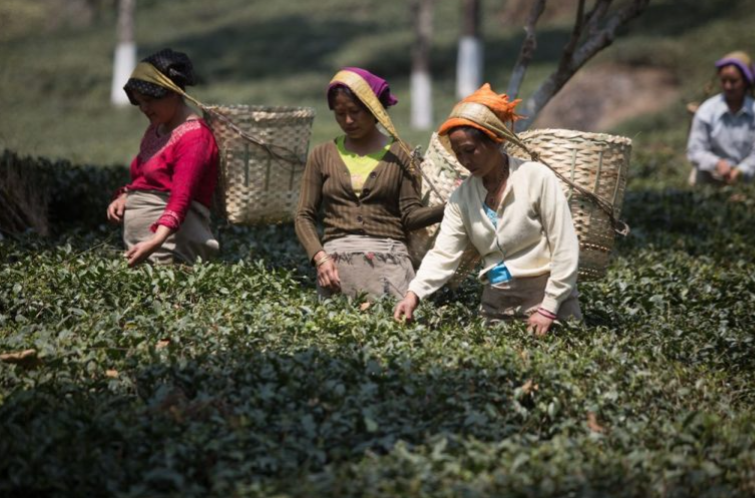Tea Plantation Industry in India (GS Paper 3, Agriculture)

Introduction
- The tea plantation industry is a crucial segment of India's agricultural sector, significantly impacting the economy and employment.
- Despite its prominence, the industry faces several challenges that affect its financial health and sustainability.
- This article delves into the state of the Indian tea industry, examining its significance, the challenges it faces, and the measures needed to secure its future.
Significance of the Indian Tea Industry
Global Standing
- Production and Export: India is the world's second-largest producer of tea and the largest producer of black tea. The country exports tea to various global markets, including Iran, Iraq, Syria, Saudi Arabia, and Russia, making it the fourth-largest tea exporter globally.
- Employment: The industry directly employs approximately 1.16 million workers, with an equal number engaged indirectly. Assam alone contributes about 55% of India's total tea production.
Recent Developments
- Production Increase: India’s tea production saw a significant increase of 39% in 2022 compared to 2008, indicating growth in the industry’s output.
Challenges Faced by the Indian Tea Industry
Economic Pressures
- Increased Input Costs: The compound annual growth rate (CAGR) of tea prices has been around 4% over the past decade. In contrast, the costs of inputs such as gas and coal have risen at a CAGR of 9-15%, squeezing profit margins for producers.
- Rising Costs: Other production costs, including wages, fuel, and fertilizers, have also risen, further impacting profitability.
Demand-Supply Discrepancies
- Production vs. Consumption: The rise in small tea growers has led to increased production that does not match domestic consumption and export demands, resulting in surplus production.
- Export Dependence: Heavy reliance on exports makes the industry vulnerable to fluctuations in global demand and trade policies.
Export Challenges
- Declining Market: The Iranian market, which accounts for about 20% of India's tea exports, has experienced a decline due to payment issues, putting financial stress on exporters.
- Price Crash: A surplus in global markets has led to a crash in international tea prices.
Quality and Sustainability Issues
- Nepal's Impact: The influx of substandard tea from neighboring countries, particularly Nepal, is threatening the quality and competitiveness of Indian tea.
- Sustainability Pressure: There is growing pressure to adopt sustainable practices in tea production, addressing soil degradation, water usage, and environmental impacts from pesticide use.
Tea Board of India
Role and Function
- Establishment and Purpose: The Tea Board of India, established under the Tea Act of 1953, operates as a statutory body under the Ministry of Commerce. Its primary functions include promoting tea cultivation, processing, domestic trade, and export.
- Headquarters: Kolkata, West Bengal.
Government Initiatives
- Education and Livelihood Support: The Tea Board has introduced schemes such as "Assistance of Education Stipend" for the children of small tea growers to improve their educational and livelihood conditions.
- Formation of Groups: The government has facilitated the creation of 352 Self Help Groups (SHGs), 440 Farmer Producer Organizations (FPOs), and 17 Farmer Producer Companies (FPCs).
- Technology Integration: The development of the mobile app “Chai Sahyog” aims to assist small tea growers in price realization and access to information.
Geographical Conditions for Tea Production
Climate and Soil Requirements
- Climate: Tea plants thrive in tropical and subtropical climates with a warm and moist environment. They require a frost-free climate year-round.
- Soil: Tea bushes need deep, fertile, well-drained soil rich in humus and organic matter.
- Temperature and Precipitation: Optimal temperatures range from 15-23°C, with annual rainfall between 150-200 cm. Frequent, evenly distributed showers are crucial for continuous growth.
Major Tea Producing States
- Primary Regions: Assam, the Darjeeling hills, and Jalpaiguri districts in West Bengal, Tamil Nadu, and Kerala.
- Additional States: Himachal Pradesh, Uttarakhand, Meghalaya, Andhra Pradesh, and Tripura also contribute to tea production.
Way Forward
Recommendations for Industry Revival
- Improving Export Infrastructure: Enhancing export infrastructure and increasing the RoDTEP (Remission of Duties or Taxes on Export Products) rate can boost competitiveness.
- Regulating Tea Waste and Imports: Regulating tea waste sold domestically at lower prices and restricting imports of poor-quality teas will help maintain industry standards.
- Promotion and Sustainability: Promoting the health benefits of tea and adopting sustainable production practices will support long-term growth and environmental stewardship.
Conclusion
- The Indian tea plantation industry holds a significant place in the country's economy, both as a major producer and exporter.
- However, the industry faces numerous challenges, including economic pressures, export dependence, and sustainability issues.
- Addressing these challenges through strategic government interventions and industry reforms is essential for ensuring the long-term viability and growth of the tea sector in India.
- By focusing on improving infrastructure, regulating quality, and adopting sustainable practices, India can enhance its position in the global tea market while supporting its vast workforce and economic interests.


